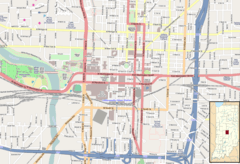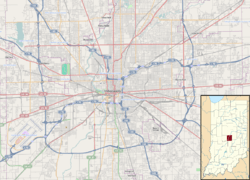Indianapolis Union Station
Indianapolis | ||||||||||||||||||||||||||||||||||||||||||||||||||||||||||||||||||||||||||||||||||||||||||||||||||||||||
|---|---|---|---|---|---|---|---|---|---|---|---|---|---|---|---|---|---|---|---|---|---|---|---|---|---|---|---|---|---|---|---|---|---|---|---|---|---|---|---|---|---|---|---|---|---|---|---|---|---|---|---|---|---|---|---|---|---|---|---|---|---|---|---|---|---|---|---|---|---|---|---|---|---|---|---|---|---|---|---|---|---|---|---|---|---|---|---|---|---|---|---|---|---|---|---|---|---|---|---|---|---|---|---|---|
 | ||||||||||||||||||||||||||||||||||||||||||||||||||||||||||||||||||||||||||||||||||||||||||||||||||||||||
| Location |
350 South Illinois Street Indianapolis, Indiana 46225 | |||||||||||||||||||||||||||||||||||||||||||||||||||||||||||||||||||||||||||||||||||||||||||||||||||||||
| Owned by | City of Indianapolis | |||||||||||||||||||||||||||||||||||||||||||||||||||||||||||||||||||||||||||||||||||||||||||||||||||||||
| Platforms | 1 island platform (formerly more) | |||||||||||||||||||||||||||||||||||||||||||||||||||||||||||||||||||||||||||||||||||||||||||||||||||||||
| Tracks | 2 (formerly more) | |||||||||||||||||||||||||||||||||||||||||||||||||||||||||||||||||||||||||||||||||||||||||||||||||||||||
| Connections |
Greyhound Lines Burlington Trailways | |||||||||||||||||||||||||||||||||||||||||||||||||||||||||||||||||||||||||||||||||||||||||||||||||||||||
| Construction | ||||||||||||||||||||||||||||||||||||||||||||||||||||||||||||||||||||||||||||||||||||||||||||||||||||||||
| Disabled access | Yes | |||||||||||||||||||||||||||||||||||||||||||||||||||||||||||||||||||||||||||||||||||||||||||||||||||||||
| Other information | ||||||||||||||||||||||||||||||||||||||||||||||||||||||||||||||||||||||||||||||||||||||||||||||||||||||||
| Station code | IND | |||||||||||||||||||||||||||||||||||||||||||||||||||||||||||||||||||||||||||||||||||||||||||||||||||||||
| History | ||||||||||||||||||||||||||||||||||||||||||||||||||||||||||||||||||||||||||||||||||||||||||||||||||||||||
| Opened | 1979 | |||||||||||||||||||||||||||||||||||||||||||||||||||||||||||||||||||||||||||||||||||||||||||||||||||||||
| Traffic | ||||||||||||||||||||||||||||||||||||||||||||||||||||||||||||||||||||||||||||||||||||||||||||||||||||||||
| Passengers (2013) |
36,162[1] | |||||||||||||||||||||||||||||||||||||||||||||||||||||||||||||||||||||||||||||||||||||||||||||||||||||||
| Services | ||||||||||||||||||||||||||||||||||||||||||||||||||||||||||||||||||||||||||||||||||||||||||||||||||||||||
| ||||||||||||||||||||||||||||||||||||||||||||||||||||||||||||||||||||||||||||||||||||||||||||||||||||||||
|
Indianapolis Union Railroad Station | ||||||||||||||||||||||||||||||||||||||||||||||||||||||||||||||||||||||||||||||||||||||||||||||||||||||||
|
South Illinois Street entrance. | ||||||||||||||||||||||||||||||||||||||||||||||||||||||||||||||||||||||||||||||||||||||||||||||||||||||||
    | ||||||||||||||||||||||||||||||||||||||||||||||||||||||||||||||||||||||||||||||||||||||||||||||||||||||||
| Location |
39 Jackson Place, Indianapolis | |||||||||||||||||||||||||||||||||||||||||||||||||||||||||||||||||||||||||||||||||||||||||||||||||||||||
| Coordinates | 39°45′47″N 86°9′34″W / 39.76306°N 86.15944°WCoordinates: 39°45′47″N 86°9′34″W / 39.76306°N 86.15944°W | |||||||||||||||||||||||||||||||||||||||||||||||||||||||||||||||||||||||||||||||||||||||||||||||||||||||
| Area | 1.3 acres (0.5 ha) | |||||||||||||||||||||||||||||||||||||||||||||||||||||||||||||||||||||||||||||||||||||||||||||||||||||||
| Built | 1886–1888 (head house); 1915–1922 (train shed) | |||||||||||||||||||||||||||||||||||||||||||||||||||||||||||||||||||||||||||||||||||||||||||||||||||||||
| Architect | Thomas Rodd | |||||||||||||||||||||||||||||||||||||||||||||||||||||||||||||||||||||||||||||||||||||||||||||||||||||||
| Architectural style | Romanesque | |||||||||||||||||||||||||||||||||||||||||||||||||||||||||||||||||||||||||||||||||||||||||||||||||||||||
| NRHP Reference # | 74000032[2] | |||||||||||||||||||||||||||||||||||||||||||||||||||||||||||||||||||||||||||||||||||||||||||||||||||||||
| Added to NRHP | July 19, 1974 | |||||||||||||||||||||||||||||||||||||||||||||||||||||||||||||||||||||||||||||||||||||||||||||||||||||||
The Indianapolis Union Station was the first union station in the world, opening on September 20, 1853, by the Indianapolis Union Railway within the Wholesale District of Indianapolis, Indiana, at 39 Jackson Place. A much larger Richardsonian Romanesque station was designed by Pittsburgh architect Thomas Rodd and constructed at the same location beginning in November 1886 and opening in September 1888. The head house (main waiting area and office) and clock tower of this second station still stand today.[3]
Amtrak, the national rail passenger carrier, continues to serve Union Station from a waiting area beneath the train shed. It is served by the Cardinal and is the eastern terminus of the Hoosier State.
Architecture
Thomas Rodd's design clearly shows the influence of noted architect Henry Hobson Richardson (1838–1886). Historian James R. Hetheringon has concluded that Pittsburgher Rodd would have studied the nearly completed Allegheny County Courthouse designed by Richardson prior to his death in 1886. Considered by Richardson to be his best work, the Courthouse was highly influential, with the Union Station one of the oldest surviving examples.[3][4][5][6]
The three-story Union Station is built of granite and brick, with a battered water table and massive brick arches characteristic of the Romanesque. It features an enormous rose window, slate roof, bartizans at section corners, and a soaring 185-foot clock tower. The 1888 station included a large street-level iron train shed.[3][7][8]
Early History
The first railroad to reach Indianapolis was the Madison and Indianapolis Railroad, which began service there in 1847. Competing railroads began connecting Indianapolis to other locations, but each had its own station in various parts of the young city, creating problems for passengers and freight alike. This problem was common to many U.S. cities, but Indianapolis was the first to solve it with a union station, which all railroads were to use. In August 1849, the Union Railway Company was formed, and it began to lay tracks to connect the various railroads. Then in 1853, it built a large brick train shed at the point where all the lines met, becoming the first union station in the United States.[3]
As Indianapolis and its railroad traffic grew, the limitations of the original structure became increasingly obvious. In 1886, Thomas Rodd was hired. At the time, Rodd was employed by the Pennsylvania Railroad, but did independent civil engineering and architectural projects on the side. The new station was completed in 1888,[7] and during 1889 320,996 passenger train cars (across 45,204 trains) and 861,991 freight cars passed through the station.[9] In 1893 approximately 25,000 passengers rode an average of 120 passenger trains daily.[3][7]
By 1900 over 200 trains a day were serviced, forcing the station to eventually build an expansive elevated platform (1915–1922[10]) so as not to interfere with regular street traffic. It was once second only to Chicago's Union Station as a Midwest railroad hub.[11]
History after World War II
After World War II, intercity passenger rail travel in the United States began to decline.[7] Throughout the 1960s and well into the post-Amtrak era the number of train passengers declined to such a trickle that in cities where rail stations didn't serve commuter traffic, most were allowed to physically decline to a point where many were closed and some demolished. Indianapolis' Union Station almost suffered that fate. By the late 1970s, vagrants and vandals had taken over much of the facility and there were numerous police and fire runs made to the cavernous building. So local business and political leaders began looking for some way to preserve this historic structure and transform it into a vital part of the city again.
The station was placed on the National Register of Historic Places on July 14, 1982.[2]
In 1984 the facility began to be converted from primary use as a railroad station to a festival marketplace by Woollen, Molzan and Partners, opening as such in 1986. Union Station became a collection of restaurants, nightclubs, and specialty stores; which included an NBC Store and a model train retailer. The eastern end of the former train platform area featured a large food court, plus several self-contained bars and nightclubs. Throughout the facility there were erected several statues of individuals who might have been seen in the railroad station in older years. A Crowne Plaza Hotel took up much of the western portion of the train shed, with twenty six of its rooms being housed within old Pullman cars.
However, in 1997 the marketplace era concluded with the departure of the last non-hotel and non-transportation tenant, a Hooters restaurant, which relocated to another nearby downtown building. The September 1995 opening of the Circle Centre Mall, just a block to the north, had drawn off the overwhelming majority of Union Station's retail customers. A planned pedestrian bridge between these two structures was denied by officials for historic preservation reasons, and a direct underground connection was deemed to be not economically feasible. So the City of Indianapolis was forced to take ownership of Union Station and began to try to find another reuse for much of the building. After some time, they began leasing out space for a wide variety of purposes, including for office use and as an indoor go-kart track.
In 2002, 21st Century Charter School was started within the facility. The still-successful hotel expanded to take up a larger portion of the building. Additional companies and organizations began to inquire about and lease space in the station. In 2006 tenants included the following: Bands of America, Consulate of Mexico (which has since relocated elsewhere downtown), Indiana Museum of African American History, Japan-America Society of America, and the Indiana Pacers academy (another charter school). Many of the building's internal directories still use Spanish as well as English, reflecting the demographic changes in Indianapolis, as well as being a left over from the days when the building housed the Mexican Consulate. The Grand Hall of Union Station is also rented out for banquets and other special events, such as a Magic: The Gathering prerelease party.
In January 2011, a new underground walkway between the newly expanded Indiana Convention Center (ICC) and nearby Lucas Oil Stadium opened. It also contains a connection to the Crowne Plaza hotel at the west end of Union Station. This climate-controlled pedestrian path replaces an old, above-ground link between the hotel and the now demolished RCA (née Hoosier) Dome, which itself was once part of the ICC and stood where the new wing of the convention center is now situated.
As to the actual passenger train service in today's Indianapolis, it is very limited. Several Amtrak trains a week to Washington, D.C. and Chicago (the Cardinal and Hoosier State) stop at the station. Passengers board from a waiting area in the southern portion of Union Station's old train shed, at street level along Illinois Street. It is co-located with the city's Greyhound bus depot, making this a multi-modal transportation hub, albeit a small one. As of early 2011, there is still no commuter or light rail service in Indianapolis, but it has long been envisioned that Union Station will serve as a possible hub if and when such services are finally established. In FY 2013 Indianapolis averaged about 99 passengers daily making it the busiest stop in Indiana served by Amtrak.
Gallery
 Station entrance
Station entrance Interior of the building, outside the former Mexican consulate
Interior of the building, outside the former Mexican consulate Images of the railroad within Union Station, looking east
Images of the railroad within Union Station, looking east Images of the railroad within Union Station, looking west
Images of the railroad within Union Station, looking west- Main hall
 North Front, 1970
North Front, 1970 Train Gates, notice bottom of steps going up, behind benches and gates to stairs in the far right
Train Gates, notice bottom of steps going up, behind benches and gates to stairs in the far right Exterior from the North front in June 2009
Exterior from the North front in June 2009
References
- ↑ "Amtrak Fact Sheet, FY2013, State of Indiana" (PDF). Amtrak. November 2013. Retrieved 3 December 2013.
- 1 2 National Park Service (2009-03-13). "National Register Information System". National Register of Historic Places. National Park Service.
- 1 2 3 4 5 "Indianapolis Union Railroad Station". Discover Our Shared Heritage Travel Itinerary. Washington, D.C.: National Park Service. Retrieved May 16, 2011.
- ↑ Shank, Wesley (1970). "Union Station: Photographs and Written Historical and Descriptive Data". Historic American Buildings Survey. Washington, D.C.: National Park Service. p. 2.
- ↑ Michael, Jesse (September 28, 2010). "The first 'union station' was a first (but the second was better)". Indianapolis Star. Indianapolis: Gannett Co.
- ↑ Floyd, Margaret Henderson (1994). Architecture After Richardson: Regionalism before Modernism – Longfellow, Alden, and Harlow in Boston and Pittsburgh. Chicago: University of Chicago Press. p. 17. ISBN 978-0-226-25410-4.
- 1 2 3 4 "Union Station: Once-bustling railroad station is one of Indianapolis' most cherished landmarks". Indianapolis Star. April 25, 2011.
- ↑ "Indiana State Historic Architectural and Archaeological Research Database (SHAARD)" (Searchable database). Department of Natural Resources, Division of Historic Preservation and Archaeology. Retrieved 2016-08-01. Note: This includes David R. Hermansen and Eric Gilbertsen (July 1974). "National Register of Historic Places Inventory Nomination Form: Indianapolis Union Railroad Station" (PDF). Retrieved 2016-08-01., Site map, and Accompanying photographs
- ↑ Staff (1 February 1890). "Railway News". The Railroad Telegrapher. Peoria, Illinois. p. 20. Retrieved 2015-08-11 – via Newspapers.com.

- ↑ 1935 Interstate Commerce Commission Valuation Report for Indianapolis Union Railway Company
- ↑ "Union Station". Emporis. 2004. Retrieved 2006-09-25.
Further reading
- Powell, Eric (2016). "Indy's Union Station still dazzles". Classic Trains. 17 (1): 76–77.
External links
![]() Media related to Union Station (Indianapolis) at Wikimedia Commons
Media related to Union Station (Indianapolis) at Wikimedia Commons
- Amtrak – Stations – Indianapolis
- Indianapolis Amtrak Station (USA Rail Guide -- Train Web)
- Rethinking Adaptive Reuse, or, How Not to Save a Great Urban Terminal by Erik Ledbetter
- Hetherington, James. "The History of Union Station" (PDF). Indiana Historical Society. Retrieved October 12, 2012.
- Indiana Historical Society page on Union Station
- Union Station from Indianapolis: a National Park Service Discover Our Shared Heritage Travel Itinerary
- Indianapolis (IND)--Great American Stations (Amtrak)


